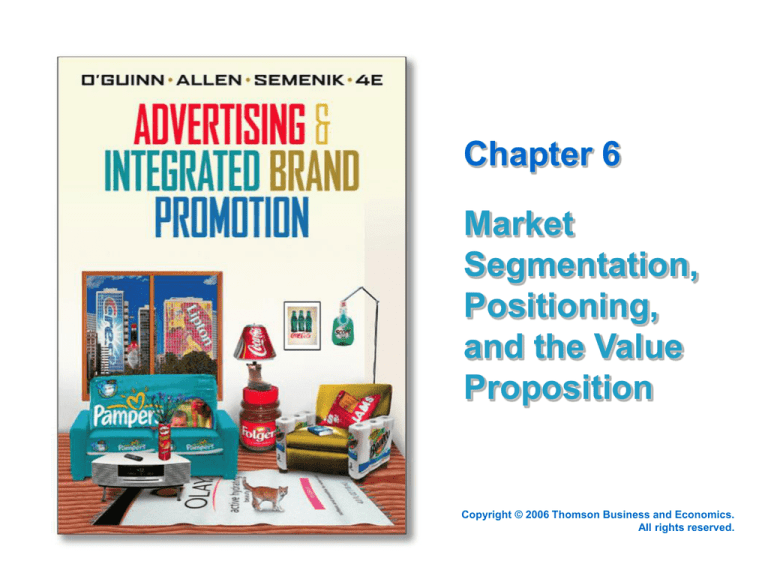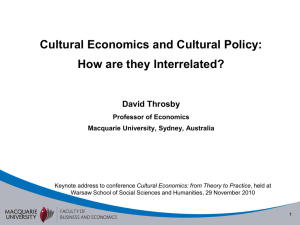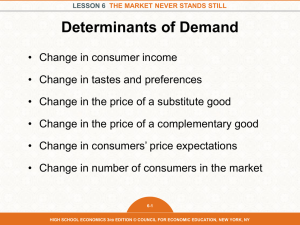
Chapter 6
Market
Segmentation,
Positioning,
and the Value
Proposition
Copyright © 2006 Thomson Business and Economics.
All rights reserved.
STP Marketing and the Evolution of
Marketing Strategy
1. Target Segment
– A sub-group of a larger market chosen as the focal
point for a marketing program or advertising
campaign.
2. Positioning
– Designing and representing a brand in a way that is
distinct in the consumer’s mind.
3. Positioning Strategy
– Selecting key themes to communicate to a target
market.
• Marketing Strategy: Evolves as a result of 1-3
Copyright © 2006 Thomson Business and Economics. All rights reserved.
6–2
Beyond STP–Regular Assessment
• Reassess segmentation strategy:
– A detailed examination of the current target segment
to develop new and better ways of meeting its needs,
or a need to change the target and reposition the
brand to a new segment.
• Pursue product differentiation strategy:
– Product differentiation is a firm’s effort to emphasize
or even create differences in brands to distinguish
them from competitors. Advertising plays a critical role
as part of the product differentiation strategy because
the consumer will have to be convinced that the
difference is meaningful.
Copyright © 2006 Thomson Business and Economics. All rights reserved.
6–3
STP Marketing
SEGMENTING:
Breaking down diverse markets into manageable
segments (smaller, more homogeneous segments)
TARGETING:
Choosing specific segments as the focal point for
marketing efforts
POSITIONING:
Aligning the marketing mix to yield distinctive appeal for
the target segment (position brand to appeal to segment)
Copyright © 2006 Thomson Business and Economics. All rights reserved.
6–4
STP Marketing
SEGMENTING:
Breaking down diverse markets into manageable
segments
Copyright © 2006 Thomson Business and Economics. All rights reserved.
6–5
Market Segmentation
• Two-step strategy
1. Identify groups of people (or
organizations) with certain shared needs
& characteristics
2. Aggregating (combining) these groups
into larger market segments according to
their mutual interest in the product’s
utility
Copyright © 2006 Thomson Business and Economics. All rights reserved.
6–6
Identifying Target Segments:
Market Segmentation
Geography
Demographics
Psychographics
Lifestyles
Commitment
Levels
Benefits
Usage Patterns
Copyright © 2006 Thomson Business and Economics. All rights reserved.
6–7
1. Behavioristic Segmentation Segmenting by Usage and Commitment
• Advertising and promotion targeted to:
– Heavy users
– Nonusers
– Brand-loyal users
– Switchers/Variety seekers
– Emergent Consumers
Copyright © 2006 Thomson Business and Economics. All rights reserved.
6–8
2. Geographic Segmentation
Copyright © 2006 Thomson Business and Economics. All rights reserved.
6–9
2. Geographic Segmentation
• Segmenting based on geographic location
• People in one region of the country (or
world) have different needs, wants, and
purchase habits
– Region, state or province, city, neighborhood
Copyright © 2006 Thomson Business and Economics. All rights reserved.
6–10
3. Demographic Segmentation
• Selecting target markets using basic
descriptors (age, gender, race, marital
status, income, education, occupation)
– Commonly used to describe identified
segments
– Often used as the starting point in market
segmentation
Copyright © 2006 Thomson Business and Economics. All rights reserved.
6–11
3. Demographic Segmentation
•
•
•
•
•
•
•
Age
Gender
Race
Marital Status
Income
Education
Occupation
Copyright © 2006 Thomson Business and Economics. All rights reserved.
6–12
4. Psychographics & Lifestyle
Segmentation
•
•
•
Grouping people based on their values,
attitudes, personality and lifestyle
AOIs – activities, opinions and interests
VALS™ “Values and Lifestyles”
Copyright © 2006 Thomson Business and Economics. All rights reserved.
6–13
4. Psychographics and Lifestyle
Segmentation
Opinions
Lifestyle
Interests
Copyright © 2006 Thomson Business and Economics. All rights reserved.
Activities
Lifestyle segmentation
provides insight into
consumers’ motivations
6–14
5. Benefit Segmentation – based on
benefits sought by the consumer
Prestige?
Passenger
Safety?
Fuel Economy?
Copyright © 2006 Thomson Business and Economics. All rights reserved.
6–15
Segmenting Business Markets
• Markets segmented by:
– Usage rates
– Geographic location
– SIC (Standard Industrial Classification) Code
– Stage in the purchase process: first time vs.
experienced buyers
– Benefits desired
Copyright © 2006 Thomson Business and Economics. All rights reserved.
6–16
STP Marketing
SEGMENTING:
Breaking down diverse markets into manageable
segments
TARGETING:
Choosing specific segments as the focal point for
marketing efforts
Copyright © 2006 Thomson Business and Economics. All rights reserved.
6–17
Target Marketing
• Settle on one or more segments as a
target for marketing & advertising efforts
• Criteria to consider:
– Do we have the proper skills to serve the
segment?
– Size of the segment & growth potential
– Intensity of the competition you are likely to
face
• Market niche: small group of consumers
with unique set of needs
Copyright © 2006 Thomson Business and Economics. All rights reserved.
6–18
STP Marketing
SEGMENTING:
Breaking down diverse markets into manageable
segments
TARGETING:
Choosing specific segments as the focal point for
marketing efforts
POSITIONING:
Aligning the marketing mix to yield distinctive appeal for
the target segment
Copyright © 2006 Thomson Business and Economics. All rights reserved.
6–19
Effective Positioning….
• …is based on the substance of the
brand’s values.
• …is consistent over time.
• …is both simple AND distinctive.
Copyright © 2006 Thomson Business and Economics. All rights reserved.
6–20
Jeep positions
itself as being
able to go where
its competitors
can’t
Copyright © 2006 Thomson Business and Economics. All rights reserved.
6–21
Marketing Mix is Key to Positioning
•
•
•
•
Product
Price
Place (Distribution)
Promotion
Copyright © 2006 Thomson Business and Economics. All rights reserved.
6–22
Product Element
• Product Life Cycle (PLC)
– Introduction
– Growth
– Maturity
– Decline
• Position in PLC affects how the product is
advertised
Copyright © 2006 Thomson Business and Economics. All rights reserved.
6–23
The Product Element
Copyright © 2006 Thomson Business and Economics. All rights reserved.
McGraw-Hill/Irwin
6–24
©2006 The McGraw-Hill Companies, Inc. All rights reserved.
Product Element – Introduction
Phase
• Stimulate primary demand – product category
• Pull Strategy – advertisements aimed at
consumers; advertisers create enough
consumer demand to pull the product through
the channels of distribution
• Push Strategy – advertisements aimed at
retailers encouraging distributors & dealers to
stock, display & advertise new products
Copyright © 2006 Thomson Business and Economics. All rights reserved.
6–25
PUSH POLICY
PULL POLICY
Producer
Producer
Wholesaler
Wholesaler
Retailers
Retailers
Consumers
Consumers
Orange-flow of communication Green-flow of products
Copyright © 2006 Thomson Business and Economics. All rights reserved.
6–26
Product Element –
Growth Phase
• Mass advertising
• Word-of-Mouth advertising
Copyright © 2006 Thomson Business and Economics. All rights reserved.
6–27
Product Element –
Maturity Phase
• Competition increases
• Emphasis is on selective demand
– Goal is to impress customers with the subtle
advantages of their particular brand
Copyright © 2006 Thomson Business and Economics. All rights reserved.
6–28
Product Element –
Decline Phase
• Companies cease promotion
• Phase out products
Copyright © 2006 Thomson Business and Economics. All rights reserved.
6–29
Price Element
• Key factors influencing price
– Market demand for product
– Cost of production
– Cost of distribution
– Competition
– Corporate objectives
– Variable influences
Copyright © 2006 Thomson Business and Economics. All rights reserved.
6–30
Place (Distribution) Element
• Direct distribution – company sells direct to
the customer
• Indirect distribution – use of a distribution
channel (not direct to customer)
Copyright © 2006 Thomson Business and Economics. All rights reserved.
6–31
Indirect distribution
• Intensive distribution: making the product
available to consumers at every possible
location (minimum effort to buy)
• Selective distribution: limiting the distribution
of a product to select outlets to reduce
distribution & promotion costs
• Exclusive distribution: severely limiting
distribution to gain a prestigious image or
maintain premium prices
Copyright © 2006 Thomson Business and Economics. All rights reserved.
6–32
Promotion Element
• Personal communication – person-to-person
contact with customers
– Personal selling
• Nonpersonal communication – uses some
medium as an intermediary for
communicating
– Advertising
– Direct marketing
– Public relations (most)
– Collateral materials
– Sales promotion
Copyright © 2006 Thomson Business and Economics. All rights reserved.
6–33
Fundamental Positioning Themes
• Benefit Positioning
• User Positioning
• Competitive Positioning
Copyright © 2006 Thomson Business and Economics. All rights reserved.
6–34
Repositioning
• Used to revive an ailing brand or fix a
lackluster new market entry
• The challenge: changing perceptions
of a brand forged over years of
advertising.
Copyright © 2006 Thomson Business and Economics. All rights reserved.
6–35
Value Proposition
• A statement of the functional, emotional,
and self-expressive benefits delivered by
the brand that provide value to customers
in the target segment. A balanced value
proposition is the basis for brand choice
and customer loyalty, and is critical to the
ongoing success of a firm.
Copyright © 2006 Thomson Business and Economics. All rights reserved.
6–36
Capturing the Value Proposition
Functional
Emotional
Self-expressive
Benefits
V
A
L
U
E
Copyright © 2006 Thomson Business and Economics. All rights reserved.
Relative Price
6–37
Examples of Value Proposition –
McDonald’s
• Functional benefits: Good-tasting hamburgers,
fries & drinks served fast; extras such as
playgrounds, prizes, premiums, and games.
• Emotional benefits:
– Kids – fun via excitement at birthday parties;
relationship with Ronald McDonald & other
characters; a feeling of special family times.
– Adults – warmth via time spent enjoying a meal with
the kids; admiration of McDonald’s social involvement
such as McDonald’s Charities and Ronald McDonald
Houses.
Copyright © 2006 Thomson Business and Economics. All rights reserved.
6–38
Examples of Value Proposition - Nike
• Functional benefits: High-technology shoe that will
improve performance and provide comfort.
• Emotional benefits: The exhilaration of athletic
performance excellence, feeling engaged, active, and
healthy; exhilaration from admiring professional &
college athletes as they perform wearing “your brand” –
when they win, you win a little bit too.
• Self-expressive benefits: Using the brand endorsed by
high-profile athletes lets your peers know your desire to
compete and excel.
Copyright © 2006 Thomson Business and Economics. All rights reserved.
6–39










